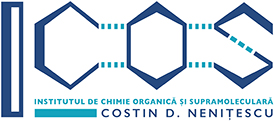
Romania’s National Recovery and Resilience Plan
High performance chiral materials for circularly polarized luminescence (CPL) and chirality induced spin selectivity (CISS) (CRUNCHINESS)
Project cod: PNRR-III-C9-2023-I8, CF 6/23.07.2023 (Contract nr. 760230/28.12.2023)
Projector director: Dr. Narcis Avarvari
Project type: Pillar III. Smart, sustainable and inclusive growth, including economic cohesion, jobs, productivity, competitiveness, research, development, and innovation, and a well-functioning
internal market with strong small and medium-sized enterprises (SMEs)
Component C9. SUPPORT FOR THE PRIVATE SECTOR, RESEARCH, DEVELOPMENT AND INNOVATION
“I8. Development of a program to attract highly specialised human resources from abroad in research, development and innovation activities”
Start date: 01 January 2024
End date: 30 June 2026
Project abstract:
Chirality is one of the most important attributes of molecules and this concept has inspired major advances in physics, chemistry and life sciences. The controlled preparation of chiral functional structures is a contemporary challenge for materials science because of the interesting properties that can arise from the resulting assemblies. The CRUNCHINESS project aims at developing advanced materials with extremely high circularly polarized luminescence (CPL) properties and spin polarization through the chirality induced spin selectivity (CISS) effect. To reach these goals, the present project will develop or use original chiral precursors pertaining to two families: 1) suitable ligands for lanthanide complexes, which are considered the most efficient CPL emitters to date. The strongest light polarized emitting complexes will be incorporated in porous silica matrices in order to access original visible and NIR emitting solid state materials, stable and easy to process, from which the lanthanide complexes are easy to recover; 2) chiral stable radicals containing helicene units. The first family will provide solid state materials showing very high circular polarization of the emitted light, while the second family will be mainly devoted to the investigation of the CISS effect. CPL active materials are of major interest in the field of optoelectronics, such as 3D-display and CP-OLED, while the CISS effect is of paramount importance as it allows the generation of spin polarized currents without the need of a permanent magnetic layer, with potential important applications in spintronics, chiral separation, and enantioselective electro- and photochemistry.
O1. The preparation of three families of chiral ligands, i.e. bpp-helicenes and analogues such as PyBox-helicenes or bis(imidazole)-pyridine (bimpy) helicenes (AA), helicene-salen derivatives (AB) and camphor-bpp (AC), together with their lanthanide complexes and to investigate their CPL activity in solution in the visible and NIR range.
O2. The controlled adsorption of the most CPL active complexes in mesostructured silica matrices such as SBA-15, and their in-depth chiroptical and photophysical study, in order to access unprecedented visible and NIR emitting materials with the possibility to recycle the lanthanide complexes.
O3. The synthesis of helicene stable radicals with covalent links between the helicene and radical units, i.e. 1,4-dihydrobenzo[1,2,4]triazinyl (Blatter’s radical) (CA), TEMPO (CB) and nitronyl-nitroxide (CC), but also fused helicene radicals, i.e. dithiazolyl-helicenes (CD), and the study of the CISS effect on single crystals and thin films.
PNRR. Finanțat de Uniunea Europeană-UrmătoareaGenerațieUE
„NRRP. Funded by European Union-NextGenerationEU”
| https://mfe.gov.ro/pnrr/ | https://www.facebook.com/PNRROficial/ |
,,The content of this material does not necessarily represent the official position of the European Union or the Government of Romania."





